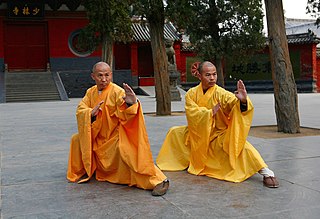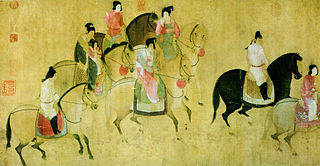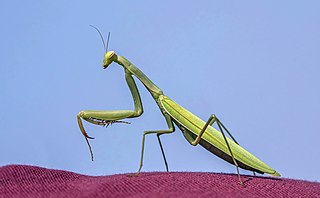
Northern Praying Mantis is a style of Chinese martial arts, sometimes called Shandong Praying Mantis after its province of origin. It was created by Wang Lang (王朗) and was named after the praying mantis, an insect, the aggressiveness of which inspired the style. One Mantis legend places the creation of the style during the Song dynasty when Wang Lang was supposedly one of 18 masters gathered by the Abbot Fu Ju (福居), a legendary persona of the historical Abbot Fu Yu, to improve Shaolin martial arts. However, most legends place Wang Lang in the late Ming dynasty.

The Qingming festival or Ching Ming Festival, also known as Tomb-Sweeping Day in English, is a traditional Chinese festival observed by the Han Chinese of mainland China, Hong Kong, Macau, Taiwan and by the ethnic Chinese of Malaysia, Singapore, Cambodia, Indonesia, Philippines, Thailand, Vietnam and Panama. It falls on the first day of the fifth solar term of the traditional Chinese lunisolar calendar. This makes it the 15th day after the Spring Equinox, either 4, 5 or 6 April in a given year. During Qingming, Chinese families visit the tombs of their ancestors to clean the gravesites, pray to their ancestors and make ritual offerings. Offerings would typically include traditional food dishes and the burning of joss sticks and joss paper. The holiday recognizes the traditional reverence of one's ancestors in Chinese culture.

A bell tower is a tower that contains one or more bells, or that is designed to hold bells even if it has none. Such a tower commonly serves as part of a Christian church, and will contain church bells, but there are also many secular bell towers, often part of a municipal building, an educational establishment, or a tower built specifically to house a carillon. Church bell towers often incorporate clocks, and secular towers usually do, as a public service.

The Chinese mantis is a species of mantis native to Asia and the nearby islands. In 1896 this species was accidentally introduced by a nurseryperson at Mt. Airy near Philadelphia, United States. Tenodera sinensis often is erroneously referred to as Tenodera aridifolia sinensis because it was at first described as a subspecies of Tenodera aridifolia, but Tenodera sinensis is now established as a full species.

Southern Praying Mantis is a Chinese martial art originating with the Hakka people. It is most closely associated with Hakka-origin styles such as Southern Dragon Kung Fu and Bak Mei.

An ootheca is a type of egg mass made by any member of a variety of species including mollusks, mantises, and cockroaches.

Tai'an is a prefecture-level city in Western Shandong Province of the People's Republic of China. Centered on Mount Tai, the city borders the provincial capital of Jinan to the north, Zibo to the east, Linyi to the southeast, Liaocheng to the extreme west and Jining to the south. To the west, Tai'an is separated from the province of Henan by the Yellow River.

Zhang Xuan (713–755) was a Chinese painter who lived during the Tang Dynasty (618–907).

Xi Shengmo also known as Pastor Hsi, was a Chinese Christian leader.
Tu'er Shen or Tu Shen, is a Chinese deity who manages love and sex between homosexual people. His name literally means "rabbit deity". His adherents refer to him as Ta Yeh.

Dōtaku are Japanese bells smelted from relatively thin bronze and richly decorated. Dotaku were used for about 400 years, between the second century B.C. and the second century C.E., and were nearly only used as decorations for rituals. They were richly decorated with patterns representing nature and animals, among which the dragonfly, praying mantis and spider are featured. Historians believe that dōtaku were used to pray for good harvests, as the animals featured are natural enemies of insect pests that attack paddy fields.

Praying towns were a series of settlements established by English colonial governments in New England from 1646 to 1675 in an effort to convert local Native Americans to Christianity. The native people who moved into these towns were known as Praying Indians. Before 1674 the villages were the most ambitious experiment in converting Native Americans to Christianity in the Thirteen Colonies, and led to the creation of the first books in an Algonquian language, including the first bible printed in British North America. During King Philip's War from 1675 to 1678, many praying towns were depopulated, in part due to forced internment of praying Indians on Deer Island, many of whom died during the winter of 1675. After the war, many of the originally allotted praying towns were never reestablished, however some praying towns persisted. Many present day indigenous groups in New England trace their heritage to praying towns, including the Mashpee Wampanoag, the Ponkapoag and Natick Massachusett, and the Chaubunagungamaug and Hassanamisco Nipmuc.

The Manchurian revival of 1908 was a Protestant revival that occurred in churches and mission stations in Manchuria.
Fan Wen was the King of Champa from 336 to 349. Fan Wen was the commander in chief to Fan Yi, and, after Fan Yi's death in 336, he seized the throne. In 340, he sent an embassy to Eastern Jin dynasty of China to request the province of Jiaozhi. His request was denied, and so Fan Wen recaptured Rinan in 347. He died two years later on another campaign.

Prays is a genus of moths of the family Praydidae, formerly assigned to Plutellidae or Yponomeutidae.
Chunyu Kun was a wit, Confucian philosopher, emissary, and official during the Chinese Warring States period. He was a contemporary and colleague of Mencius.

Mantises are an order (Mantodea) of insects that contains over 2,400 species in about 460 genera in 33 families. The largest family is the Mantidae ("mantids"). Mantises are distributed worldwide in temperate and tropical habitats. They have triangular heads with bulging eyes supported on flexible necks. Their elongated bodies may or may not have wings, but all Mantodea have forelegs that are greatly enlarged and adapted for catching and gripping prey; their upright posture, while remaining stationary with forearms folded, has led to the common name praying mantis.

Thian Fah Foundation Hospital, shortened to Thian Fah Foundation is the first foundation and private hospital in Thailand, including shrine. Located at 606 Yaowarat Road, Samphanthawong Subdistrict, Samphanthawong District, Bangkok near Wat Traimit, Odeon Circle and Chaloem Buri Intersection.
Zhù is a Chinese surname., meaning ‘wizard’, ‘prayers’, or ‘to pray’ in ancient Chinese. The origin of the name is either from Zhu (祝), an official post in ancient China in charge of chanting prayers during religious worship, or (ii) from Zhu (祝), the name of a fief located in modern-day Shandong province during the reign of King Wu of Zhou. According to a 2013 study, it was the 138th-most common surname in China, shared by 1,20,000 people or 0.090% of the population, with the province with the most being Zhejiang.













